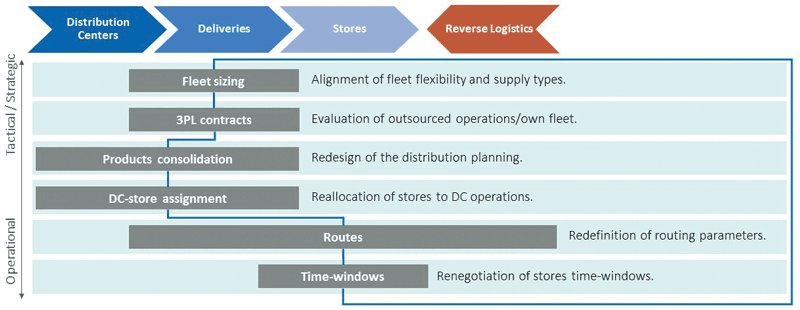by Pedro Amorim, Sara Martins, Eduardo Curcio and Bernardo Almada-Lobo, INESC TEC
Large food retailers have to deal with a complex distribution network with multiple distribution centres, different temperature requirements, and a vast range of store formats. This project used an optimization-simulation approach to help food retailer Sonae MC make the best decisions regarding product-warehouse-outlet assignment, product delivery modes planning and fleet sizing.
In the food retail sector, maintaining food quality across the supply chain is of vital importance. Product quality is dependent on storage and transportation conditions. Compared with other types of retailers the supply chain is very complex, and is best considered as an amalgamation of three types of intertwined food supply chains: frozen, chilled and ambient [1].
Store formats vary among food retailers, in terms of size, product ranges and sales volumes. To be closer to and more convenient for their customers, retailers are opening new stores every year in new locations. The allocation of new stores to the distribution centres is frequently defined ad hoc. These allocations affect the distribution of the different product categories (temperatures) and the operational capacity of the warehouses [2]. Furthermore, poor distribution planning might result in low vehicle utilization and consequently in an overestimated fleet size and/or a fleet mix that is unnecessarily costly. Since product-warehouse-outlet assignment (assignment to distribution centres), product delivery mode planning (direct shipping and/or hub-and-spoke) and fleet sizing (types and dimensions) are inter-related, solving them separately results in oversimplification. However, tackling these decisions simultaneously requires extremely complex mathematical programming which is unfeasible for the real world. Furthermore, existing literature in this field fails to include critical ingredients, such as the consistency of the operations throughout the year, rendering the proposed approaches not applicable.
A real-world case
Sonae MC is the leading grocery retailer in Portugal. Its store outlet is divided in three segments: hypermarkets, supermarkets and convenience stores. To supply its 210 stores (franchising stores are not considered here) with 60,000 products, it relies on two hubs and two specialized warehouses (for fish and meat). Stores are supplied every day with a dedicated, heterogeneous fleet and transportation related annual costs amount to around 40 million euros.
Recently, thanks to an optimization-simulation driven approach developed at INESC TEC, Sonae MC has improved its distribution network and it was able to cut transportation related costs by more than 750 thousand euros, while maintaining the same service level to stores. After several iterations, Sonae MC selected a solution that simplifies and segregates the distribution of the different product categories. This allowed for a reduction of the fleet size and a change in the fleet mix. Additionally, it has performed some adjustments in the warehouse-outlet assignment that has resulted in reduced warehouse operational costs.

Figure 1: Overview of the opportunities tackled in the project.
Hybridize to simplify
A hybrid approach was used to simplify the problem. This was necessary in order to cope with the complexity and interdependencies of the decisions presented by this real-world scenario. First, several what-if scenarios were defined, based on real-world practice, to identify a distribution framework that achieves transportation savings. At this stage the different store allocation and product delivery modes are analysed. Secondly, an optimization algorithm proposed by Amorim et al. (2012) for routing problems considering heterogeneous fleet and time-windows has been adapted to define the routes [3]. The different processes and decisions give rise to considerable operational complexity, so the evaluation of the solution is best done in a simulation environment. This allows operational and financial Key Performance Indicators (KPIs) to be obtained and any readjustments to be made before making any real implementation. The simulation model, at the final step, provides valuable insights on the implementation of strategic and tactical decisions.
Managers at Sonae MC, impressed by the quality of the solutions provided, the user friendly outputs and the automatically generated inputs, decided to put these new solutions into practice. To ensure a smooth transition, adoption was progressive: the new distribution planning process was implemented gradually, and with the new operational performance the number of vehicles was reduced. The implications of the project go beyond better decisions: the project highlights the advantages of looking at operations from a different perspective - with a focus on cost optimization - that may yield solutions that would not be easily devised empirically.
This project was developed by the Centre for Industrial Engineering and Management of INESC TEC, in Portugal. It started in November 2014 and concluded in April 2015. The estimated savings of the project have already been achieved by the company, ensuring a pay-back within a few months. This research is being extended towards a more quantitative scenario generation step.
References:
[1] Akkerman, Renzo et al.: “Quality, safety and sustainability in food distribution: a review of quantitative operations management approaches and challenges”, Or Spectrum 32.4 (2010): 863-904.
[2] A. H. Hübner et al.: “Demand and supply chain planning in grocery retail: an operations planning framework”, International Journal of Retail & Distribution Management 41.7 (2013): 512-530.
[3] Amorim, Pedro, et al: “A rich vehicle routing problem dealing with perishable food: a case study”, Top 22.2 (2014): 489-508
Please contact:
Sara Sofia B. Martins
INESC TEC, Porto, Portugal
Tel: +351 22 209 4370











